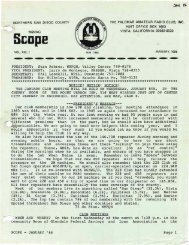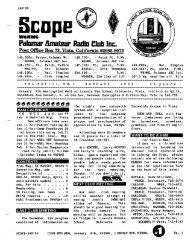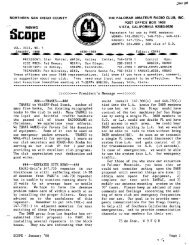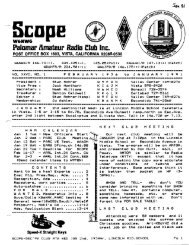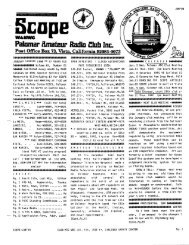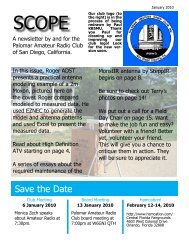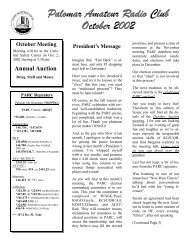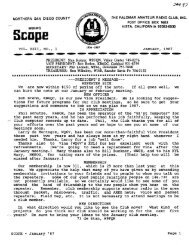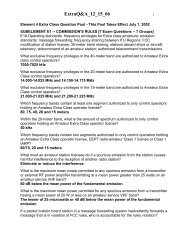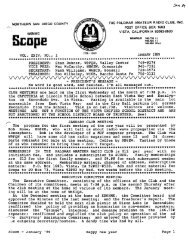You also want an ePaper? Increase the reach of your titles
YUMPU automatically turns print PDFs into web optimized ePapers that Google loves.
~Ed)<br />
more than two additional solar cycle<br />
Solar flux and sunspot numbers peaks seems remote, at least at this<br />
were down again this week. Average stage in life. One can only hope. At<br />
sunspot numbers were down by over 66 least by the era of cycle 23 we have so<br />
points and average solar flux by almost many more tools available than we did<br />
43 when compared to the previous in earlier cycles, and with internet connections<br />
the availability of these obser<br />
week.<br />
Last week's bulletin ARLP040 vation and forecasting aids has come<br />
pointed out that the average daily solar right down to the level of the average<br />
flux values for the past three calendar ham.<br />
quarters were all about the same, We may wish for more sunspots, but<br />
around 182 (180.5 for the first quarter, along with more activity comes more<br />
182.9 for the second quarter, and 181.9 sofar flares and coronal mass ejections<br />
for the quarter year just completed). which increase polar absorption of radio<br />
The average daily flux for September signals. These events are often interesting<br />
to aurora watchers and VHF enthu<br />
was 182.1, right at this same value.<br />
The past week's average solar flux was siasts, but can be a problem for HF<br />
152.6, well below this average. communications. October 5 was a day<br />
We are surely at the peak of this of big geomagnetic disturbance, when<br />
solar cycle. Since there is so much daily the planetary A index reached 96 and<br />
variation in solar indices, we won't there was a sustained period when the K<br />
know until much later when the peak index was seven, indicating a severe<br />
actually occurred. This year's values, geomagnetic storm. The high latitude<br />
although higher than last year's, look indices were worse, with Alaska's college<br />
A index at 105 and K index as high<br />
flat when examining the first nine<br />
months of this year.<br />
as eight.<br />
Solar watchers and HF radio aficionados<br />
wonder if during the final from October 6-9. In fact, on October<br />
Geomagnetic indices were very quiet<br />
quarter the sun will give us some more 8 Alaska's college A and K indices were<br />
activity, yielding a later peak. Since the zero for the entire day, which is highly<br />
average radio amateur does not actually unusual. Solar flux reached a recent<br />
see many solar cycles during a lifetime, short term minimum of 139.6 on October<br />
10.<br />
this is a subject of keen interest.<br />
As a young child, the author of this As this bulletin is written, activity is<br />
bulletin missed the most exciting again increasing. Planetary A index is<br />
sunspot cycle of all, cycle 19 in 1958. expected to rise to 35 on Friday, October<br />
13, then hit 15 the next day and 12<br />
As a young ham at age 12 in early 1965,<br />
I joined the amateur service at the solar for Sunday and Monday. Solar flux<br />
minimum between cycles 19 and 20. values for the same four days are predicted<br />
to be 170, 180, 195 and 205.<br />
The peak of cycle 20 around age 17 was<br />
a bit of a disappointment, especially The current rise in geomagnetic activity<br />
after listening to the<br />
is due to a full halo coronal mass ejection<br />
at the end of the UTC day on<br />
stories of the older brethren who gloried<br />
in the peak ofcycle 19.<br />
October 9. This resulted in an interplanetary<br />
shock wave that hit earth's<br />
Cycles 21 and 22 around age 27 and<br />
38 were more exciting than cycle 20, magnetosphere at 2330 UTC on October<br />
12.<br />
but one could only hope for another<br />
cycle 19 or better. Now at age 48, the Solar flux is expected to peak at 220<br />
probable peak of this cycle is not standing<br />
out as anything remarkable, and the below 200 until October 28. The next<br />
around October 18 and 19, and not dip<br />
question arises of how many more cycles<br />
will I get to see, and what will they pected around November 5-7. Average<br />
short term solar flux minimum is ex<br />
be like? At an average I I years per solar flux predicted for the next 45 days<br />
cycle, the probability of seeing much is 191, which is a bit higher than the<br />
average for the first three quar- pg.ll<br />
.119·<br />
ters of this year. Ofcourse, this 1.455<br />
could be an artifact ofthe period Nov.<br />
we are looking at, which includes<br />
two upcoming peaks based on<br />
the 27.5 day solar rotation.<br />
Sunspot numbers for October 5<br />
through 11 were 145, 127, 94, ]28,<br />
106, 95 and 131 with a mean of 118.<br />
10.7 cm flux was 173.8, 158.1, 155.6,<br />
148.9, 140.8, 139.6 and 151.4, with a<br />
mean of 152.6, and estimated planetary<br />
A indices were 96,6, 7, 5, 5, 12 and 14<br />
with a mean of20.7. NNNNIEX<br />
Contests<br />
Harry Hodges W6YOO@amsat.org<br />
Nov 4 ARRL Sweepstakes, CW<br />
Nov 10 Japan Int;1 OX Contest. SSB<br />
Nov 11 WAE OX Contest, RITY<br />
Nov 11 OK/OM OX Contest, CW&SSB<br />
Nov 11 Ukrainian OCX Contest, CW&SSB<br />
Nov 18 ARRL Sweepstakes, SSB<br />
Nov 25 CQ WW OX Contest, CW<br />
Dec I ARRL 160-Meter Contest<br />
Dec 2 TARA RTfY Sprint<br />
Dec 9 ARRL IO-Meter Contest<br />
Use the ARRL Sweepstakes as an<br />
opportunity to increase your WAS<br />
count and the CQ WW DX Contest to<br />
increase your DXCC count on CWo<br />
F or the digital buffs there's a couple<br />
of neat RTTY tests.<br />
Rules are in QST, CW, NCJ. &<br />
Worldradio magazines. 73, Harry<br />
Autopatcb<br />
The 486 W3LFRGary donated computer<br />
has been operating continously<br />
from early summer until the present<br />
without a problem.<br />
Since it is a color computer, it has<br />
been programmed to display various<br />
aspects of what is going on in various<br />
colors and flashing numbers to call attention<br />
to important items: the repeater<br />
used if it is not 147.130, callsign of<br />
user, membership information, and hour<br />
of use.<br />
Red is used to call attention to improperly<br />
dialed numbers or incomplete<br />
numbers due to fading or interference.<br />
The monitor computer screen can be<br />
seen from several rooms away and as<br />
long as the face has a blue background,



